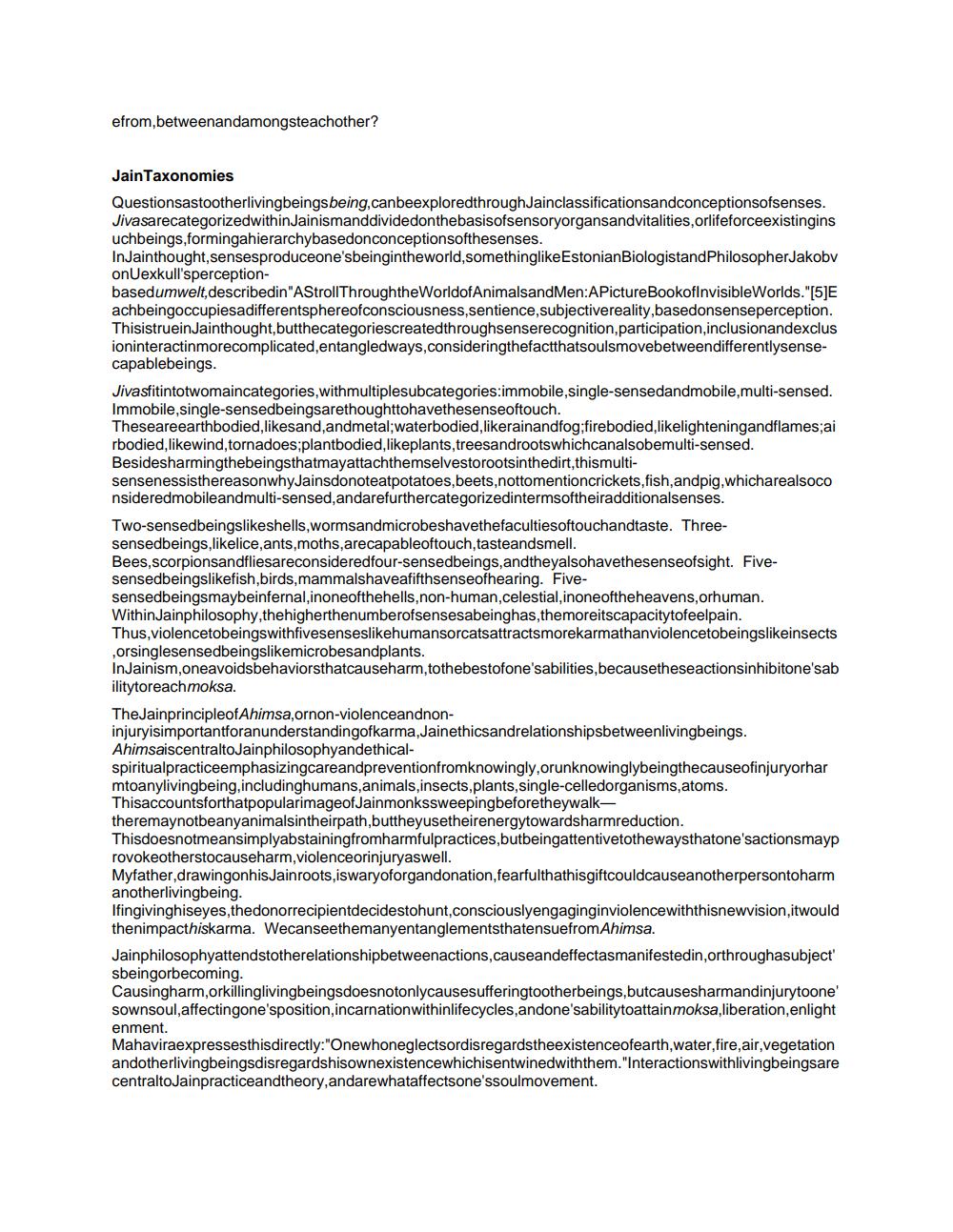________________
efrom, betweenandamongsteachother?
Jain Taxonomies Questionsastootherlivingbeingsbeing,canbeexploredthroughJainclassificationsandconceptionsofsenses. Jiva sarecategorizedwithin Jainismanddividedonthebasisofsensoryorgansandvitalities, orlifeforceexistingins uchbeings, formingahierarchybasedonconceptionsofthesenses. InJainthought, sensesproduceone'sbeingintheworld, somethinglike EstonianBiologistandPhilosopherJakoby onUexkull'sperceptionbasedumwelt,describedin "A StrollThroughthe WorldofAnimalsand Men:APicture BookoflnvisibleWorlds."[5]E achbeingoccupiesadifferentsphereofconsciousness,sentience,subjectivereality, basedonsenseperception. Thisistruein Jainthought, butthecategoriescreatedthroughsenserecognition, participation, inclusionandexclus ioninteractinmorecomplicated, entangledways, consideringthefactthatsoulsmovebetween differentlysensecapablebeings. Jivasfitintotwomaincategories,withmultiplesubcategories:immobile,single-sensedandmobile,multi-sensed. Immobile,single-sensedbeingsarethoughttohavethesenseoftouch. Theseareearthbodied,likesand, andmetal;waterbodied,likerainandfog;firebodied,likelighteningandflames;ai rbodied, likewind, tornadoes;plantbodied, likeplants, treesandrootswhichcanalsobemulti-sensed. Besidesharmingthebeingsthatmayattachthemselvestorootsinthedirt,thismultisensenessisthereasonwhyJainsdonoteatpotatoes,beets,nottomentioncrickets, fish,andpig, whicharealsoco nsideredmobileandmulti-sensed, andarefurthercategorizedintermsoftheiradditionalsenses. Two-sensedbeingslikeshells, wormsandmicrobeshavethefacultiesoftouchandtaste. Threesensedbeings, likelice,ants,moths,arecapableoftouch, tasteandsmell. Bees, scorpionsandfliesareconsideredfour-sensedbeings, andtheyalsohavethesenseofsight. Fivesensedbeingslikefish,birds, mammalshaveafifthsenseofhearing. Fivesensedbeingsmaybeinfernal,inoneofthehells, non-human,celestial, inoneoftheheavens,orhuman. Within Jainphilosophy, the higherthenumberofsensesabeinghas, the moreitscapacitytofeelpain. Thus, violencetobeingswithfivesenseslikehumansorcatsattractsmorekarmathanviolencetobeingslikeinsects orsinglesensedbeingslikemicrobesandplants. In Jainism,oneavoidsbehaviorsthatcauseharm, tothebestofone'sabilities, becausetheseactionsinhibitone'sab ilitytoreachmoksa. The JainprincipleofAhimsa,ornon-violenceandnoninjuryisimportantforanunderstandingofkarma, Jainethicsandrelationshipsbetweenlivingbeings. AhimsaiscentraltoJainphilosophyandethicalspiritualpracticeemphasizingcareandpreventionfromknowingly,orunknowinglybeingthecauseofinjuryorhar mtoanylivingbeing, includinghumans, animals, insects, plants, single-celledorganisms, atoms. Thisaccountsforthatpopularimageof Jainmonkssweepingbeforetheywalktheremaynotbeanyanimalsintheirpath,buttheyusetheirenergytowardsharmreduction. Thisdoesnotmeansimplyabstainingfromharmfulpractices, butbeingattentivetothewaysthatone'sactionsmayp rovokeotherstocauseharm, violenceorinjuryaswell. Myfather,drawingonhis Jainroots, iswaryoforgandonation, fearfulthathisgiftcouldcauseanotherpersontoharm anotherlivingbeing. Ifingivinghiseyes, thedonorrecipientdecidestohunt,consciouslyengaginginviolencewiththisnewvision, itwould thenimpacthiskarma. Wecanseethemanyentanglementsthatensuefrom Ahimsa. Jainphilosophyattendstotherelationshipbetweenactions,causeandeffectasmanifestedin, orthroughasubject' sbeingorbecoming. Causingharm,orkillinglivingbeingsdoesnotonlycausesufferingtootherbeings, butcausesharmandinjurytoone sownsoul, affectingone'sposition, incarnation withinlifecycles,andone'sabilitytoattainmoksa,liberation, enlight enment. Mahaviraexpressesthis directly:"Onewhoneglectsordisregardstheexistenceofearth, water, fire, air,vegetation andotherlivingbeingsdisregardshisownexistencewhichisentwinedwiththem."Interactionswithlivingbeingsare centralto Jainpracticeandtheory,andarewhataffectsone'ssoulmovement.




